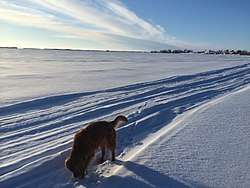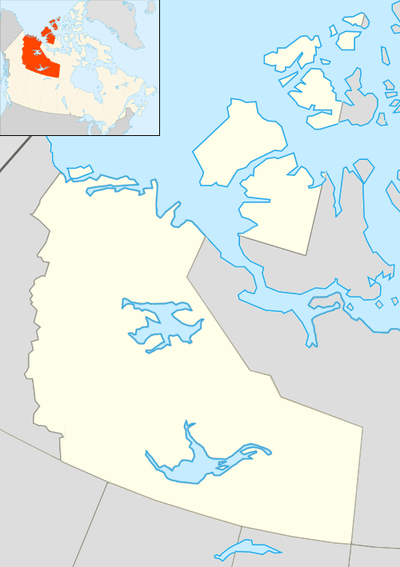Whatì
| Whatì Wha Tì Tsõtì Mïne Kö Golàa | ||
|---|---|---|
| First Nation | ||
 | ||
| ||
 Whatì  Whatì | ||
| Coordinates: 63°08′40″N 117°16′22″W / 63.14444°N 117.27278°WCoordinates: 63°08′40″N 117°16′22″W / 63.14444°N 117.27278°W | ||
| Country | Canada | |
| Territory | Northwest Territories | |
| Region | North Slave Region | |
| Constituency | Mackenzie Delta | |
| Census division | Region 3 | |
| North West Company trading post | 1793 | |
| Incorporated | 4 August 2005 | |
| Government | ||
| • Chief | Alfonz Nitsiza | |
| • Senior Administrative Officer | Lisa Nitsiza | |
| • MLA | Jackson Lafferty | |
| Area[1] | ||
| • Land | 59.95 km2 (23.15 sq mi) | |
| Elevation | 269 m (883 ft) | |
| Population (2016)[1] | ||
| • Total | 470 | |
| • Density | 7.8/km2 (20/sq mi) | |
| Time zone | UTC−7 (Mountain (MST)) | |
| • Summer (DST) | UTC−6 (MDT) | |
| Canadian Postal code | X0E 1P0 | |
| Area code(s) | 867 | |
| Telephone exchange | 573 | |
| - Living cost | 152.5A | |
| - Food price index | 145.7B | |
|
Sources: Department of Municipal and Community Affairs,[2] Prince of Wales Northern Heritage Centre,[3] Canada Flight Supplement[4] ^A 2013 figure based on Edmonton = 100[5] ^B 2015 figure based on Yellowknife = 100[5] | ||
Whatì (from the Dogrib language meaning "Marten Lakes"), officially the Tłı̨chǫ Community Government of Whatì[6] is a First Nations community in the North Slave Region of the Northwest Territories, Canada. Whatì is located by Lac La Martre, about 164 km (102 mi) northwest of the territorial capital of Yellowknife.
History
With rich and varied wildlife, the area has long been a favoured hunting ground of the Tłı̨chǫ (Dogrib Dene) Indigenous people. The North West Company established a trading post there in 1793, and many natives began settling there permanently, while they continued to hunt and fish in the area. With the establishment of a trading post at Fort Rae on Great Slave Lake in the late 19th century, most regional trading was accomplished at the Hudson's Bay Company and free traders posts there. A trading post at Lac La Martre was not again established until the 1920s.[7]
On 1 January 1996, the community officially changed its name from Lac La Martre to the Tłı̨chǫ name "Wha Ti", meaning "Marten Lake," the same meaning as the French and then on 4 August 2005[3] to the current spelling. Other traditional Tłı̨chǫ names for the settlement include Tsoti ('fouled water lake') and Mine Go Kola ('net fishing with houses').[3]
Demographics
At the 2016 Census the population was 470, an decrease of 4.5% over the 2011 Census. The majority of the population is Indigenous of which 445 were First Nations and 10 were Métis. The main languages were Dogrib and English with a few North Slavey speakers.[1]
In 2017 the Government of the Northwest Territories reported that the population was 522 with an average yearly growth rate of 0.6% from 2007.[5]
| Historical population | ||||||||||||||||||||||||||||||||||||||||||||||||||||||||||
|---|---|---|---|---|---|---|---|---|---|---|---|---|---|---|---|---|---|---|---|---|---|---|---|---|---|---|---|---|---|---|---|---|---|---|---|---|---|---|---|---|---|---|---|---|---|---|---|---|---|---|---|---|---|---|---|---|---|---|
|
| |||||||||||||||||||||||||||||||||||||||||||||||||||||||||
| Sources: NWT Bureau of Statistics (2001 - 2017)[8] | ||||||||||||||||||||||||||||||||||||||||||||||||||||||||||
Economy
While trapping, hunting, and fishing continue to be the main economic activities in this traditional community, efforts have been made to develop tourism as well. A fishing lodge was opened, and many tourists come to see the abundant wildlife, including black bears, barren-ground caribou, wolves, and eagles. The community takes special pride in the fact that no alcohol is allowed there.
Whatì is part of the Tlicho Government.[9]
See also
References
- 1 2 3 Census Profile, 2016 Census Whatì, Community government (Census subdivision), Northwest Territories and Northwest Territories (Territory)
- ↑ "NWT Communities - Whatì". Government of the Northwest Territories: Department of Municipal and Community Affairs. Retrieved 2014-01-29.
- 1 2 3 "Northwest Territories Official Community Names and Pronunciation Guide". Prince of Wales Northern Heritage Centre. Yellowknife: Education, Culture and Employment, Government of the Northwest Territories. Archived from the original on 2016-01-13. Retrieved 2016-01-13.
- ↑ Canada Flight Supplement. Effective 0901Z 19 July 2018 to 0901Z 13 September 2018.
- 1 2 3 Whatì - Statistical Profile at the GNWT
- ↑ Differences in Community Government Structures
- ↑ Free Traders in Northland Start Again, The Edmonton Bulletin, May 6, 1922
- ↑ Population Estimates By Community from the GNWT
- ↑ Whatì at the Tlicho Government
External links

- Official website